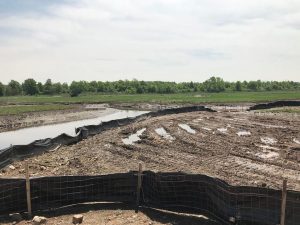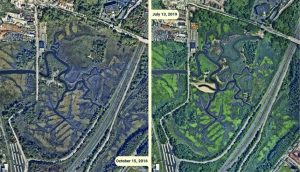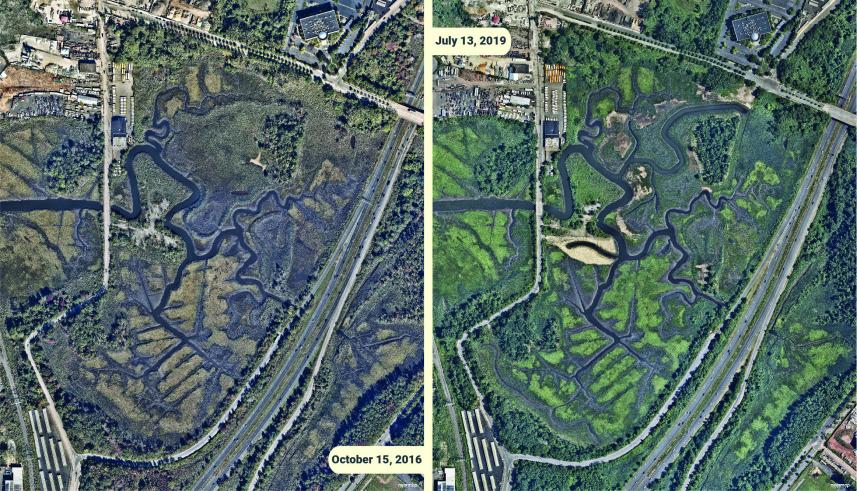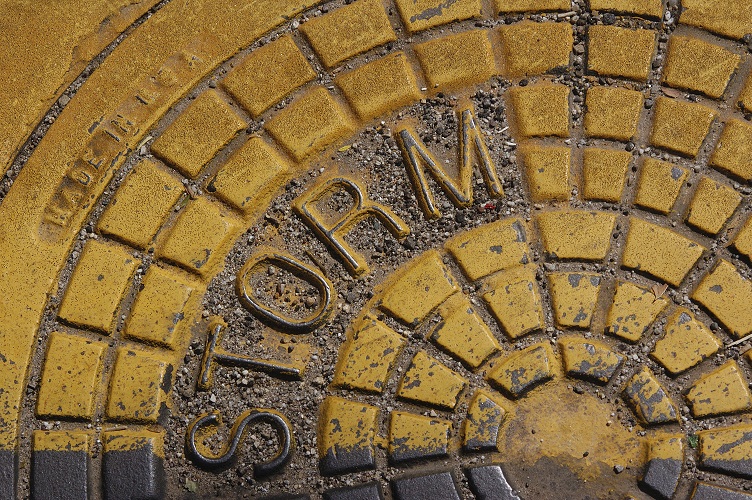In today’s urban development landscape, striking a balance between economic prosperity and environmental stewardship is increasingly difficult.
If property developers fill wetlands and other natural landforms that accept stormwater runoff, provide habitat for wildlife, and control erosion, the result is often increased flooding and decreased biodiversity. On the other hand, development can stagnate if local environmental regulations are too burdensome, keeping cities from realizing their full economic potential.
Ahead of a $1.6 billion revitalization project in New York City’s Staten Island borough, the New York City Economic Development Corp. (EDC) is piloting an innovative strategy to simplify regulatory compliance and save developers money without compromising the benefits of the New York-New Jersey Harbor Estuary’s remaining wetlands.
Banking on impact mitigation
As the most densely populated city in the U.S. continues to grow ever more dense, the New York City metro area has lost about 85% of its coastal wetlands over the last century, the city government estimates. Much of the wetlands that remain sit along Staten Island’s largely undeveloped western shore in an area called Saw Mill Creek.

On the western shore of Staten Island in New York City, municipal agencies are trialing an innovative approach to balancing economic development with environmental stewardship. The city’s first wetland mitigation bank, established in January 2018, attaches a financial incentive to wetland restoration work while simplifying regulatory compliance for developers. Photo courtesy of New York City Economic Development Corp.
To preserve Saw Mill Creek’s wetlands while enabling developers to breathe new life into the island many New Yorkers know as “the forgotten borough,” EDC partnered with the New York City Department of Parks and Recreation to establish the city’s first wetland mitigation bank at Saw Mill Creek in early 2018.
Under the wetland mitigation bank model, public or private organizations that improve or preserve wetland habitats in the New York-New Jersey Harbor Estuary receive financial rewards in the form of credits. An independent regulator quantifies the number of credits generated by a certain level of wetland rehabilitation work. These credits can then be sold to developers whose construction plans would involve disturbing wetlands in the same watershed.
State and federal laws require waterfront developers to receive permits before they build structures in water. A common permit requirement is to demonstrate environmental impact mitigation, an often-lengthy process, which EDC estimates can cost developers upward of $2 million per acre in New York City. Developers can purchase credits to help satisfy their impact mitigation requirements at a typically lower cost and in a shorter timeframe than traditional alternatives.
Establishing a conservation marketplace
To demonstrate the model’s viability for Saw Mill Creek, EDC and its partners have been hard at work generating the first wetland mitigation credits by restoring wetlands in western Staten Island since January 2018.
According to an update on the project released by EDC in October, crews have dredged up more than 30,500 m3 (40,000 yd3) of debris and contaminated sediment. In addition to rehabilitating about 30 acres of impaired wetlands back to functional quality, the work also involved constructing about 24 acres of new wetlands, according to the EDC release.

In October, the New York City Economic Development Corp. provided an update on the Saw Mill Creek Wetland Mitigation Bank project. During the last 2 years, crews have removed more than 30,500 m3 (40,000 yd3) of debris and contaminated sediment from the Saw Mill Creek wetlands, restoring or creating approximately 54 acres of undeveloped land that improves water quality, enhances flood prevention, and provides habitat for wildlife. Photo courtesy of New York City Economic Development Corp.
Improving 54 acres of wetlands in total generated approximately 13 tradeable credits for the mitigation bank, each currently valued at a minimum reserve price of $1.5 million. Talks are already underway between EDC and developers in the watershed, which includes Staten Island, Manhattan, the Bronx, and portions of Brooklyn and Queens, to sell these new credits, reported Curbed New York.
EDC expects to use profits from credit sales to restore an additional 15 acres of wetlands, generating more credits until the pilot project concludes in August 2021. With each new stretch of wetland reclaimed, New York City is increasing its resilience against climate change and improving local water quality, described freshman U.S. Rep. Max Rose, who represents Staten Island and parts of Brooklyn, in a statement.
“The Saw Mill Creek Wetland project is proof that we can take care of the environment in a way that is good for business and that will protect us against future storms,” Rose said. “When we use every tool at our disposal to protect ourselves from future storms, that’s a win-win for Staten Island.”
Read more about the Saw Mill Creek Wetland Mitigation Bank project in the Autumn 2018 issue of World Water: Stormwater Management magazine.





